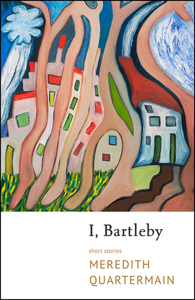Reviews
Fiction Review by Matthew K. Thibeault
Meredith Quartermain, I, Bartleby (Vancouver: Talonbooks, 2015). Paperbound, 118 pp., $14.95.
 “Quirky” is the first adjective used in the blurb on the back of Meredith Quartermain’s short fiction collection I, Bartleby. I decided to take out my OED at about thirty pages into the book to be sure my understanding of “quirky” wasn’t skewed somehow by growing up on television (my first memory of the word “quirky” was its defensive use by my father during a family viewing of Napoleon Dynamite, when my mother’s chosen adjective was “stupid”). It seemed, to me, to mean silly, or not serious. Quirky feels somehow applicable to Wes Anderson but not David Lynch, to Jonathan Franzen but not David Foster Wallace, or to Thomas Pynchon but certainly not to William Gaddis. The dictionary defines quirky as “characterized by peculiar or unexpected traits,” so I guess what is meant by “quirky” here is publisher-speak for fiction that uses subtle observations to evoke something about the quiet desperation that surrounds North American adult life; at least this applies to the book’s first section, Caravan. This first section, for me, introduced a feeling of self-consciousness or a kind of distorted self-perception, not all that surprising considering most of these stories are about writing or writers in one way or another.
“Quirky” is the first adjective used in the blurb on the back of Meredith Quartermain’s short fiction collection I, Bartleby. I decided to take out my OED at about thirty pages into the book to be sure my understanding of “quirky” wasn’t skewed somehow by growing up on television (my first memory of the word “quirky” was its defensive use by my father during a family viewing of Napoleon Dynamite, when my mother’s chosen adjective was “stupid”). It seemed, to me, to mean silly, or not serious. Quirky feels somehow applicable to Wes Anderson but not David Lynch, to Jonathan Franzen but not David Foster Wallace, or to Thomas Pynchon but certainly not to William Gaddis. The dictionary defines quirky as “characterized by peculiar or unexpected traits,” so I guess what is meant by “quirky” here is publisher-speak for fiction that uses subtle observations to evoke something about the quiet desperation that surrounds North American adult life; at least this applies to the book’s first section, Caravan. This first section, for me, introduced a feeling of self-consciousness or a kind of distorted self-perception, not all that surprising considering most of these stories are about writing or writers in one way or another.
Part of the fun of reading Quartermain is that she can begin with tight-lensed, microscopic close-ups, and long, Proustian observations that draw from fragments of childhood and expand into the moments that triggered them, before pulling out and leaving us with the stone wall of a post-daydream reality. “We don’t sweep around curves, jut up risers, or swoop down descenders, curling and uncurling a c or an s, looping and knitting our letters. Nowadays our neurons manage rows of on-off switches, fingers wired to three or four buttons commanded by imagined letters, the conveyancers of thought, printed in our brains. Except for lists of milk, bread, and apples. Or receipts handed out by someone taking away a rug to clean. Or the cramped script on tiny lines of dental records using the universal tooth numbering system: watch 7; replace amalgam in 12 and 29; scaling, two units; recommended extraction 32.”
Like Proust, Quartermain works in the space between moments, between what is happening and the faint mnemonic triggers that exist in momentary webs of memory and thought. In this way she seems to enable us to experience abstractions and imagery on a kind of subconscious level. “…he took me through rain-soaked streets past darkened windows of the Chinese Times and the shops that sold incense, bamboo fans, tea, and golden roaring lions, shops of mannequins wearing silk sheaths of sapphire, turquoise, scarlet, and pearl embroidered with dragons or plum blossoms or paisley teardrops, high-collared dresses that hugged hips and bust, had slits up the thighs, and a row of frog buttons closing the placket over the right breast.”
The stories read very much at the speed and flow of thought, and the author’s approach is every bit as smart and imaginative as Barth or Barthelme, although nothing feels like a game (actually, there is one story titled “There Real Fictional House of His Imagined Film Director,” in which she does, in a fun way, kind of jerk us around a bit); these are more meditative, and Quartermain is more a companion than a puzzle maker. She’s getting at something important about us, about the torments surrounding banalities, and memories, and childhood, and writing. The collection’s average story length is about one-and-a-half pages, which seems to be the size of the author’s structural comfort zone: those longer than four pages begin to lose steam and wrap themselves up in ways that feel awkward and unsubtle. An example of a longer-than-two-pages story that seems to lose its composure is “Scriptorium” (also the title of the third section), which begins strongly, builds delicately, and really seems to promise something as structurally gorgeous as her sentences, before diverging into what feels like a smart teenager’s viciously scribbled thoughts about the failings of her father. Structural wavering aside, the final (and longest) story, “Moccasin Box,” does an acrobatic job of solidifying themes and tying both ends of the book together in a way that many collections fail to do. Above all, it’s Meredith Quartermain’s dexterity in channelling lives and landscapes to explore the symptoms of our post-millennial malaise that make I, Bartleby both wickedly smart and fun to read.
—Matthew K. Thibeault









